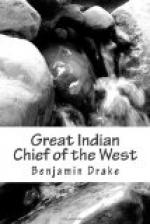“Make me your leader,” he boldly exclaimed; “let our young men follow me, and the pale-faces shall be driven back to their towns. Let the old men and the women, and all who are afraid to meet the white man, stay here, but let your braves go to battle.” Such intrepid conduct, could not fail to produce its effect upon a race so excitable as the Indians. The warriors with one voice, declared they were ready to follow Keokuk; and he was at once chosen to lead them against the enemy. It turned out, however, that the alarm was false, but the eloquence of Keokuk in the council, and his energy in preparing for the expedition, placed him at once in the first rank of the braves.
His military reputation, was, on another occasion, much increased, by the skill and promptness with which he met a sudden emergency on the battle field. With a party of his braves, Keokuk was hunting in the country which lies between the residence of the Sacs and that of the Sioux, betwixt whom, for many years, a deadly hatred had existed. Very unexpectedly, a party of the latter well mounted, came upon them. The Sacs were also on horseback, but their enemies being superior horsemen and fully equipped for war, had a decided advantage. There was no covert from behind which the Sacs could fight, and flight was impossible. Keokuk’s mode of defence was as novel as ingenious. He instantly formed his men into a compact circle, ordered them to dismount, and take shelter behind their horses, by which movement they were protected from the missiles of the Sioux, and at the same time placed under circumstances in which they could avail themselves of their superiority as marksmen. The Sioux, raising the war-whoop, charged upon their entrenched foe with great fury, but were received with a fire so destructive that they were compelled to fall back. The attack was repeated but with the same result. The hordes could not be forced upon those whose guns were pouring forth vollies of fire and smoke, and after several unsuccessful attempts to break the line, the Sioux retreated with considerable loss.
At a subsequent period, during a cessation of hostilities between these tribes, the Sacs had gone to the prairies to hunt buffalo, leaving their village but slightly protected by braves. During the hunt Keokuk and his band, unexpectedly approached an encampment of a large number of Sioux, painted for war, and evidently on their way to attack his village. His own braves were widely scattered over the extensive plains, and could not be speedily gathered together. Possessing the spirit of a fearless and generous mind, he instantly resolved upon the bold expedient of throwing himself between the impending danger and his people. Unattended, he deliberately rode into the camp of his enemy. In the midst of their lodges rose the war-pole, and around it the Sioux were dancing, and partaking of those fierce excitements, by means of which the Indians usually prepare themselves for battle.




